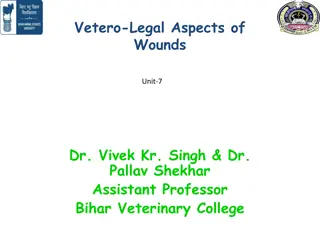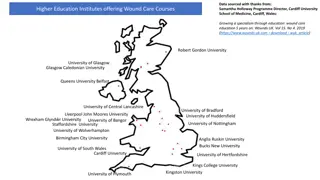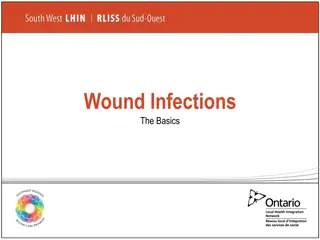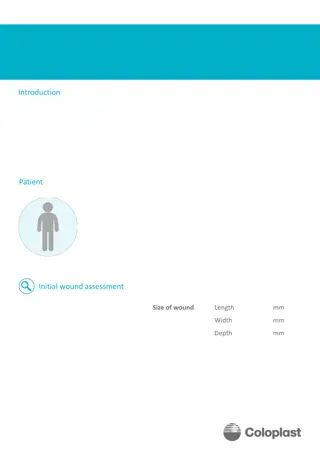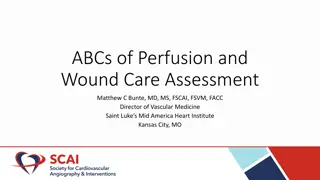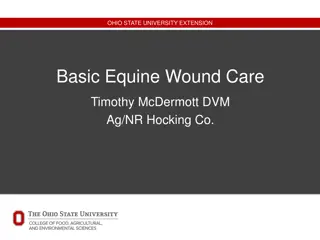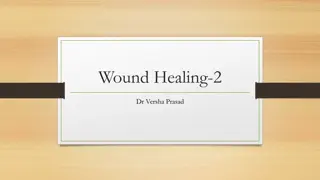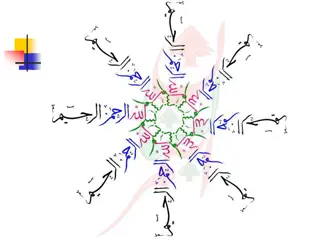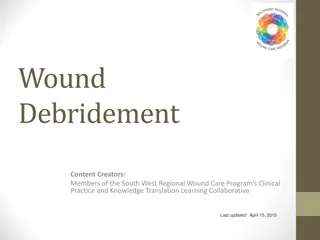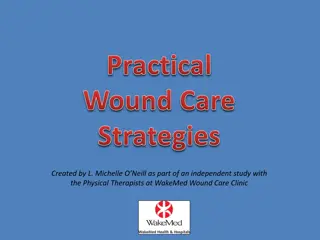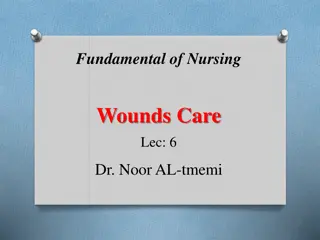Wounds and wound healing
Delve into the intricate world of wounds and wound healing as discussed by Kareem Waheed. This enlightening content explores the mechanisms, treatments, and importance of effective wound care. Gain valuable knowledge on promoting healing and preventing complications in the healing process.
Download Presentation

Please find below an Image/Link to download the presentation.
The content on the website is provided AS IS for your information and personal use only. It may not be sold, licensed, or shared on other websites without obtaining consent from the author.If you encounter any issues during the download, it is possible that the publisher has removed the file from their server.
You are allowed to download the files provided on this website for personal or commercial use, subject to the condition that they are used lawfully. All files are the property of their respective owners.
The content on the website is provided AS IS for your information and personal use only. It may not be sold, licensed, or shared on other websites without obtaining consent from the author.
E N D
Presentation Transcript
Wounds and wound healing By Kareem Waheed
WOUNDS It is a break or disruption in the normal integrity of the skin , mucous membranes, bone, or any body organ.
Wound Classification 1. Intentional or unintentional 2. Open or closed 3. Acute or chronic 4. Partial-thickness (all or a portion of the dermis is intact), 5. full-thickness (the entire dermis and sweat glands and hair follicles are severed), 6. complex (the dermis and underlying subcutaneous fat tissue are damaged or destroyed).
Intentional Wounds and Unintentional Wounds An intentional wound is the result of planned invasive therapy or treatment. Such as surgery, intravenous therapy, and lumbar puncture.
Unintentional wounds are accidental: These wounds occur from unexpected trauma, such as from accidents, forcible injury (such as a stabbing or a gunshot), and burns.
Open and Closed Wounds An open wound: The skin surface is broken A closed wound: The skin surface is not broken, but soft tissue is damaged, and internal injury and hemorrhage may occur.
Acute and Chronic Wounds Acute wounds, such as surgical incisions, usually heal within days to weeks. Chronic wounds: The delayed. the risk of infection is increased. healing process is
Wound Wound Healing Healing is a quality of living tissue; it is also referred to as regeneration (renewal) of tissues. Healing
Phases of Wound Healing Phases of Wound Healing 1- Defensive (Hemostasis and Inflammatory) Phase occurs immediately after injury and lasts about 3 to 4 days. The major events that occur in this phase are hemostasis and inflammation. 2- Proliferative Phase:- the second phase in healing, It is begins on the third or fourth day after injury and lasts 2 to 3 weeks. 3- Maturation Phase;- the final stage of healing, begins about the 21 day and may continue for up to 2 years or more,
Defensive (Hemostasis and Inflammatory) Phase occurs immediately after injury and lasts about 3 to 4 days. The major events that occur in this phase are hemostasis and inflammation. Hemostasis, or cessation of bleeding, occurs by vasoconstriction. Platelets, activated by the injury, aggregate to stop the bleeding. Formation of fibrin and a fibrinous meshwork, which provides initial wound closure, and inhibits contamination of the wound by microorganisms. Inflammation plasma protein systems stimulate the release of various chemical mediators, such as histamine, serotonin,, and kinins. These substances cause blood vessels to dilate. The increased blood supply carries nutrients and oxygen, and transports leukocytes to the area to participate in phagocytosis. The increased blood supply also removes the debris and dead cells. The area is red, edematous, and warm to touch..
Reconstructive (Proliferative) Phase It is begins on the third or fourth day after injury and lasts 2 to 3 weeks. This phase contains the process of collagen deposition, angiogenesis, granulation tissue contraction. Collagen is the most rich protein in the body and is the material of tissue repair. Angiogenesis, the formation of new blood vessels, begins within hours after the injury. The membrane opens, and new endothelial cells build a new vessel. capillaries grow across the wound, increasing blood flow, which increases wound healing. Repair begins as granulation tissue, or new tissue, grows surrounding healthy connective, growth of epithelial tissue, begins. Wound contraction is the final step of the reconstructive phase of wound healing. development, and wound
Maturation Phase Maturation, the final stage of healing, begins about the 21stday and may continue for up to 2 years or more, depending on the depth and extent of the wound. During this phase, the scar tissue is remodeled Although the scar tissue continues to gain strength, it remains weaker than the tissue it replaces. Capillaries eventually disappear (a scar that is white because it lacks a blood supply).
http://classconnection.s3.amazonaws.com/964/flashcards/520964/png/healing1321212453488.pnghttp://classconnection.s3.amazonaws.com/964/flashcards/520964/png/healing1321212453488.png
Factors affecting wound healing Age Nutrition Oxygenation Smoking Drug therapy Diabetes mellitus
Guideline in Wound Cleaning Guideline in Wound Cleaning Remove of hair Remove visible debris tissue Remove excessive or dry crusting exudates. Use Isotonic saline to clean or irrigate the wound. Warm the solution to body temperature before use. If wound is grossly contaminated by foreign material, bacteria, or necrotic tissue, clean the wound at every dressing change. If wound is clean, has little exudate, and reveals healthy tissue avoid repeated cleaning. Use gauze squares. Avoid using cotton balls and other products that shed fibers into the wound surface. The fibers become embedded in the granulation tissue and act as a source for infection
Purpose of wound Dressings Purpose of wound Dressings 1. To protect the wound from mechanical injury. 2. To protect the wound from microbial contamination. 3. To provide or maintain high humidity of the wound. 4. To absorb drainage or debride the wound. 5. To prevent hemorrhage. 6. To splint or immobilize the wound site and prevent further injury.
Complications of Wound Healing Complications of Wound Healing 1. Hemorrhage: some escape of blood from a wound is normal, but persistent bleeding is abnormal. 2. Hematoma: localized collection of blood underneath the skin, and may appear as a reddish blue swelling. 3. Infection.






